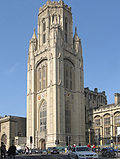Nurse married Anne Teresa (née Talbott) in 1971; they have two daughters – Sarah, who works for ITV, and Emily, [45] a physicist based at University College London and CERN. [46] [1] He describes himself as a sceptical agnostic. [14]
Political views
Nurse has been a member of the Labour Party for nearly 40 years and is a patron of Scientists for Labour, a socialist society affiliated to them. [47] In September 2020, he was a co-author on a letter in Nature alongside the former prime minister Gordon Brown highlighting the importance of EU funding in the fight against COVID-19. [48]
As an undergraduate student at Birmingham, Nurse sold Socialist Worker , and participated in an occupation of the vice-chancellor's office. [46] [49] As a graduate student at East Anglia he continued to sell Socialist Worker, and was sympathetic to the International Socialist Tendency but never formally joined the movement. [50]
Nurse has criticised potential Republican Party candidates for the US presidential nomination for opposing the teaching of natural selection, stem cell research on cell lines from human embryos, and anthropogenic climate change, even partially blaming scientists for not speaking up. [51] He was alarmed that this could happen in the US, a world leader in science, "the home of Benjamin Franklin, Richard Feynman and Jim Watson". [51]
One problem, Nurse said, was "treating scientific discussion as if it were political debate," using rhetorical tricks rather than logic. Another was the state of science teaching in the schools, which does not teach citizens how to discuss science – particularly in religious schools, even in the United Kingdom. [51] Nurse has written that "we need to emphasise why the scientific process is such a reliable generator of knowledge with its respect for evidence, for scepticism, for consistency of approach, for the constant testing of ideas." [51] Furthermore, Nurse feels that scientific leaders "have a responsibility to expose the bunkum". They should take on politicians, and expose nonsense during elections. [51]
In August 2014, Nurse was one of 200 public figures who were signatories to a letter to The Guardian expressing their hope that Scotland would vote to remain part of the United Kingdom in September's referendum on that issue. [52]
Nurse believes that scientists should speak out about science in public affairs and challenge politicians who support policies based on pseudoscience. [53]


